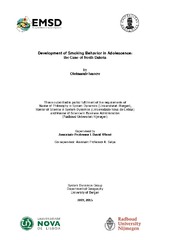| dc.description.abstract | This thesis describes a modeling project, performed by Oleksandr Ivanov, a student enrolled in European Master Program in System Dynamics, in cooperation with assistant professor Arielle Selya (University of North Dakota) and under the supervision of associate professor I. David Wheat (University of Bergen). The fieldwork was conducted in Grand Fork, North Dakota, the USA in April-June 2015. The main problem is devoted to the prevalence in smoking cigarettes among adolescents (middle school and high school students) in North Dakota. Despite the comprehensive anti-tobacco policies implemented since 1998, more than 20% of high school students are still exposed to a smoking habit. Among the reasons for this are high nicotine dependence level and the low state excise tax for tobacco products. The thesis provides an overview of main driving forces and feedbacks within the system of smoking development, pointing out peer and parental pressure, nicotine dependence and other ambient factors (cigarette availability, exposure to second-hand smoking, etc.). Additionally, the research explores potential consequences of the boom in the market of e- cigarettes under different scenarios. Particular focus is made on the policy analysis and implementation, testing tax, informational, compliance and ban on flavors policies towards meeting Healthy People 2020 objectives. It was found that the increase in the state tobacco excise tax by 1.56 usd is the most promising policy. If implemented in 2016, it would benefit the society by 1381 lives saved from the premature death and total saved costs of 1204 billion usd by 2032. The thesis is structured as follows. Chapter 1 provides an introduction to the problem, observes current trends in smoking, formulates research objectives and research questions, and discusses the research methodology. Chapter 2 describes the model structure in stock-and-flow and causal loop perspectives. Chapter 3 tests the initial hypothesis by model simulations. Chapter 4 is devoted to the process of model validation. Chapter 5 suggests policy options, analyses their cost-effectiveness, and provides a detailed action plan. | en_US |
